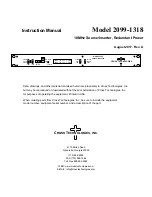
TMS320F2810, TMS320F2811, TMS320F2812
TMS320C2810, TMS320C2811, TMS320C2812
www.ti.com
SPRS174T – APRIL 2001 – REVISED MAY 2012
6.27 External Interface Ready-on-Write Timing With One External Wait State
Table 6-39. External Memory Interface Write Switching Characteristics (Ready-on-Write, 1 Wait State)
PARAMETER
MIN
MAX
UNIT
t
d(XCOH-XZCSL)
Delay time, XCLKOUT high to zone chip-select active-low
1
ns
t
d(XCOHL-XZCSH)
Delay time, XCLKOUT high or low to zone chip-select inactive-high
–2
3
ns
t
d(XCOH-XA)
Delay time, XCLKOUT high to address valid
2
ns
t
d(XCOHL-XWEL)
Delay time, XCLKOUT high/low to XWE low
2
ns
t
d(XCOHL-XWEH)
Delay time, XCLKOUT high/low to XWE high
2
ns
t
d(XCOH-XRNWL)
Delay time, XCLKOUT high to XR/W low
1
ns
t
d(XCOHL-XRNWH)
Delay time, XCLKOUT high/low to XR/W high
–2
1
ns
t
en(XD)XWEL
Enable time, data bus driven from XWE low
0
ns
t
d(XWEL-XD)
Delay time, data valid after XWE active-low
4
ns
t
h(XA)XZCSH
Hold time, address valid after zone chip-select inactive-high
(1)
ns
t
h(XD)XWE
Hold time, write data valid after XWE inactive-high
TW – 2
(2)
ns
t
dis(XD)XRNW
Maximum time for DSP to release the data bus after XR/W inactive-high
4
ns
(1)
During inactive cycles, the XINTF address bus will always hold the last address put out on the bus. This includes alignment cycles.
(2)
TW = trail period, write access. See
Table 6-30
.
Table 6-40. Synchronous XREADY Timing Requirements (Ready-on-Write, 1 Wait State)
(1)
MIN
MAX
UNIT
t
su(XRDYsynchL)XCOHL
Setup time, XREADY (synchronous) low before XCLKOUT high/low
15
ns
t
h(XRDYsynchL)
Hold time, XREADY (synchronous) low
12
ns
Earliest time XREADY (synchronous) can go high before the sampling
t
e(XRDYsynchH)
3
ns
XCLKOUT edge
t
su(XRDYsynchH)XCOHL
Setup time, XREADY (synchronous) high before XCLKOUT high/low
15
ns
t
h(XRDYsynchH)XZCSH
Hold time, XREADY (synchronous) held high after zone chip-select high
0
ns
(1)
The first XREADY (synchronous) sample occurs with respect to E in
Figure 6-35
:
E = (X XWRACTIVE) t
c(XTIM)
When first sampled, if XREADY (synchronous) is found to be high, then the access will complete. If XREADY (synchronous) is found to
be low, it will be sampled again each t
c(XTIM)
until it is found to be high.
For each sample, setup time from the beginning of the access can be calculated as:
D = (X XWR n – 1) t
c(XTIM)
– t
su(XRDYsynchL)XCOHL
where n is the sample number (n = 1, 2, 3, and so forth).
Table 6-41. Asynchronous XREADY Timing Requirements (Ready-on-Write, 1 Wait State)
(1)
MIN
MAX
UNIT
t
su(XRDYasynchL)XCOHL
Setup time, XREADY (asynchronous) low before XCLKOUT high/low
11
ns
t
h(XRDYasynchL)
Hold time, XREADY (asynchronous) low
8
ns
Earliest time XREADY (asynchronous) can go high before the sampling
t
e(XRDYasynchH)
3
ns
XCLKOUT edge
t
su(XRDYasynchH)XCOHL
Setup time, XREADY (asynchronous) high before XCLKOUT high/low
11
ns
t
h(XRDYasynchH)XZCSH
Hold time, XREADY (asynchronous) held high after zone chip-select high
0
ns
(1)
The first XREADY (synchronous) sample occurs with respect to E in
Figure 6-36
:
E = (X XWRACTIVE – 2) t
c(XTIM)
When first sampled, if XREADY (asynchronous) is found to be high, then the access will complete. If XREADY (asynchronous) is found
to be low, it will be sampled again each t
c(XTIM)
until it is found to be high.
For each sample, setup time from the beginning of the access can be calculated as:
D = (X XWRACTIVE – 3 + n) t
c(XTIM)
– t
su(XRDYasynchL)XCOHL
where n is the sample number (n = 1, 2, 3, and so forth).
Copyright © 2001–2012, Texas Instruments Incorporated
Electrical Specifications
137
Submit Documentation Feedback
Product Folder Link(s):
TMS320F2810 TMS320F2811 TMS320F2812 TMS320C2810 TMS320C2811 TMS320C2812
















































